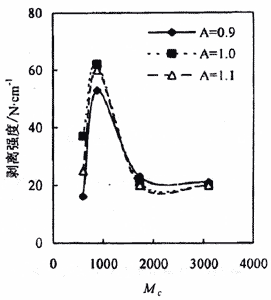2. Results and discussion
2.1. Effect of Feeding Ratio on Molecular Weight and Water Absorption of Amino Terminal Polyurethane
The isocyanate group (-NCO) is particularly active, and its reaction with hexanediol or ethylenediamine can be performed almost quantitatively. Controlling the relative amount of toluene 2,4-diisocyanate (TDI) and hexanediol in the reactants (q=<-NCO>/<-OH>) to prepare amino-terminated polyurethanes of different molecular weights (ATPU, see Synthetic Roadmap 1). Table 1 shows the relationship between q and the molecular weight (Mc) of synthetic ATPU and its water absorption. It can be seen that as q decreases from 2.0 to 1.1, Mc gradually increases and its water absorption decreases, indicating that as Mc increases, its polarity decreases. When Mc=600, ATPU's Rw is 1.7%, which is much lower than that of other commonly used epoxy resin curing agent fatty amine systems, but it still shows that it has a certain degree of water absorption. It can be seen that in order to reduce the effect of moisture on the performance of the adhesive, care should be taken to prevent water absorption during ATPU storage. Comparing the Theoretical Value of ATPU Molecular Weight The experimental value of the known value, the relationship between the molecular weight of the ATPU Mc and q can be well consistent with the linear step-growth theory, to meet the test (2):
Mc=1/ (q-1) × M + MTDI + 2MEDA (2)
In the formula, M is the molecular weight of the repeating unit: MTDI is the molecular weight of TDI: MEDA is the molecular weight of ethylenediamine.
Table 1 Effect of reactants on the molecular weight and water absorption of ATPU
Product Name Unit Price (yuan/t) Construction Consumption (g/m2)Material cost (yuan/m2)
Dry film thickness (μm) Polyurethane coating of this project 27000950~100022.65~27.20> 35090% Ceramic epoxy coating (United States) 550002000110.001000100100% Polyurethane coating (United States) 45000150067.501000 Chlorinated polypropylene coating (domestic) 22500100022.50150~180* (Mc) theory is calculated according to equation (2); (Mc) is actually calculated according to equation (1).
2.2. Effect of Molecular Weight of Amino Terminal Polyurethane on Mechanical Properties of Adhesives 
Fig. 2 Effect of the molecular weight of ATPU on the adhesive peel strength A is the equivalent ratio of ATPU and epoxy resin, the same
The mechanical properties of the adhesive are closely related to the molecular structure of the curing agent. As shown in Fig. 1, the ATPU molecule contains a large amount of urethane group-NHCOO- and a very flexible hydrocarbon fatty chain -(CH2)6-, and has a highly reactive aliphatic amine group, thus The adhesive formulated with epoxy resin can not only be cured at room temperature, but also expected to have impact resistance, good flexibility, high peel strength, strong adhesion, and good resistance to high and low temperature properties. Figure 2 shows the effect of the molecular weight of the ATPU (Mc) on the peel strength of adhesives with different ratios. It can be seen that as (Mc) increases, the peel strength of the adhesive appears at its maximum. This is because as the molecular weight of ATPU increases, on the one hand, the crosslinking density and the cohesive energy density in the adhesive are reduced; at the same time, the fluidity and wettability of the adhesive are also deteriorated, thereby reducing the adhesion of the adhesive to the aluminum alloy metal. Focus on (see Figure 3); on the other hand, the soft segment between the cross-links becomes longer, improving the flexibility of the adhesive (see Figure 4). Figure 2 also shows that when the Mc is small, the equivalence ratio of the flexible curing agent to the epoxy resin is 1.0, and the adhesive peeling is the most moderate. When the ATPU or cross-link density is reduced, the mechanical strength is reduced. However, with the increase of Mc, the amount of flexible curing agent has little effect on the adhesive peel strength.

Figure 3 Effect of ATPU Molecular Weight on Adhesive Adhesion

Figure 4 Effect of ATPU Molecular Weight on Adhesive Flexibility
The test also showed that the 0.6 mm thick adhesive coated with amine-terminated polyurethane with a molecular weight of about 880 and bisphenol A glycidyl ether epoxy resin, when cured at room temperature (23-32°C), has a tack-free time of less than After 24 hours, after 72 hours, its comprehensive mechanical properties reach 80°C for 6 hours, ie its peel strength is ≥ 58N/cm, adhesion is ≥ 14.6 MPa, and flexibility is <12 mm. This shows that by designing and synthesizing a suitable flexible curing agent with a molecular structure, the flexibility of the epoxy resin can be significantly improved, and as the curing time is further extended, the comprehensive mechanical properties are further improved. At the same time, it has room-temperature curing and strong adhesion to aluminum alloy metal, which is expected to realize the engineering application of bisphenol A glycidyl ether epoxy resin adhesive in the wave-absorbing coating of supersonic aircraft. (Text / Guan Jianguo, Wang Wei, Gong Rongzhou)